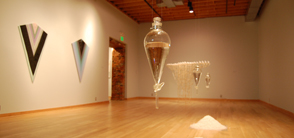Artist Mia Wiener embroiders provocative images on white linen because she's fascinated by the intimate nature of textiles and by the way that most people take them for granted.
Emily C-D creates collages in her native Baltimore and also in Mexico from materials that other people throw away: discarded newspapers, bottle tops, string, and old pots and pans.
And Ashley Minner crafts nearly life-size portraits of Baltimore's Native-American Lumbee community that revel in the beauty and strength of the people with whom she grew up.
The women are part of the generation that will determine the form that the visual arts will take here in the future and are being highlighted in "Thirty: 30 Creative Minds Under 30," a group of 10 gallery talks sponsored by Maryland Art Place. The trio have been selected to present their artwork in the debut presentation on Wednesday; the remaining nine events will take place roughly once a month.
"For a while, we've really been wanting to do a speaker series that includes not just Baltimore artists, but also curators, conservators, art historians and creative mind," says Sofia Rutka, the gallery's program manager.
"We can do only about eight or 10 exhibitions a year, and we were trying to find a way to showcase more artists. Baltimore has a lot of excellent creative minds who don't have as much of a platform to talk about their ideas as they should."
More than 100 painters, sculptors and conservators applied, and that group was winnowed down to the 21/2 dozen who program organizers thought would be especially articulate and provocative.
Participants were told that they would talk for about 10 minutes apiece and then field questions. To get their creative juices flowing, coordinators posed such potential topics as: What is the relationship between your art and business? Who is your audience? And how do you relate to current trends in the art world?
Weiner, for instance, has sewed since she was a child. Though she knew at an early age that she would become an artist, she initially assumed she'd create primarily in more traditional genres.
Eventually, she realized that her most satisfying times were when she sat down with an embroidery needle and a pattern of her own devising.
"Fiber art hasn't always been the most respected medium, partly because women did it and partly because it was associated with domestic tasks," she says. "It wasn't until the 1960s that it started being collected in museums."
For her talk on Wednesday, Weiner will display a series of nude portraits of conjoined couples. The artist first sketched from live models and then used black thread to embroider the images onto white linen panels that are about three feet high and five feet wide.
"I'm particularly interested in textiles because they surround us," says the 22-year-old, who will graduate in May from the Maryland Institute College of Art.
"We cover our bodies with them every day. Our curtains, napkins and our carpet are all textiles. They are very, very intimate objects that hold their own history and memory. And it's such a loaded history. There are issues of gender and of colonization. Entire economies are based off of textiles and trading."
Like Weiner, the artist who calls herself Emily C-D tries to get people to take a new look at materials so familiar and mundane that they're easily overlooked. But she doesn't care if the result of all her hard work vanishes overnight. In fact, she expects it to be destroyed.
"I'm a mixed-media and community artist, so a lot of my work is ephemeral," says the 29-year-old collage-maker, a Baltimore resident. "I might build a giant sculpture of metal and wood and old furniture by the side of a street, but I don't expect it to be there in a year or 10 or 20. What's important is the action of doing it, not that it lasts."
Emily C-D divides her time between Baltimore and Mexico and finds that her projects in cities thousands of miles away influence each other. When she speaks Wednesday at Maryland Art Place, the artist will describe workshops for children that she conducted in Mexico City and Oaxaca.
"I taught them to make instruments out of abandoned materials," she says. "We made one-string guitars from two-liter soda bottles, and maracas from papier-mache and bottle tops, and then we followed up the workshops with a public performance.
"In Mexico City, the children performed in a black-box theater on the instruments they'd made. In Oaxaca, we made this large, colorful snake from plastic bottles and paraded it through the streets. Then we threw the bottle snake into the river, ran after it, pulled it out and threw it back in again."
When Emily C-D is in Baltimore, she and Minner occasionally cross paths. Not only are both women community artists, but both graduated from MICA in 2005. Unlike Emily C-D, the 29-year-old Minner has dedicated her life to working with one population in particular: Baltimore's Lumbee community.
Minner's community art takes a variety of forms. For instance, the artist conducts a grant-writing workshop for girls ages 5 to 11. The kids decide which projects to pursue, write their own grant applications and secure their own funding. The largest donation they've received so far is $3,000 from the Baltimore branch of Youth As Resources.
"They're very impressive and skillful young ladies," Minner says. "They can explain to you the difference between making a decision by consensus and by voting, and why achieving consensus is better."
At the other end of the age spectrum, the artist has recorded a series of audio histories with the Lumbee elders who first moved to Maryland from North Carolina after World War II.
And she's excited about a series of 30 life-size portraits of people in her own generation that she and photographer Sean Sheidt created together.
Minner told her subjects to wear whatever clothes they felt the most comfortable in. When the artist's neighbors and friends arrived at the studio, they filled out surveys designed to elicit positive thoughts about themselves and their lives.
Sheidt photographed them in a golden light meant to impart a superhero glow, and Minner added text taken from the surveys to the finished portraits. They called the result "The Exquisite Lumbee Project."
"The most important thing to me in the work that I do is to help people see the divinity in each other and in themselves," Minner says.
"I want people to realize that we're all precious and we're all going to die. So, it's important for us to love each other and lift one another up."
mary.mccauley@baltsun.com
If you go
"Thirty: 30 Creative Minds Under 30" begins at 6 p.m. Wednesday at Maryland Art Place, 8 Market Place. For information, call 410-962-8565 or visit mdartplace.org.


.jpg)
.png)
.png)
